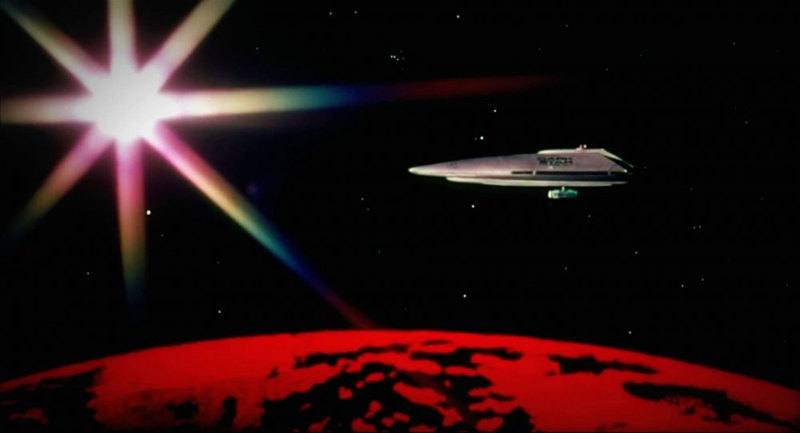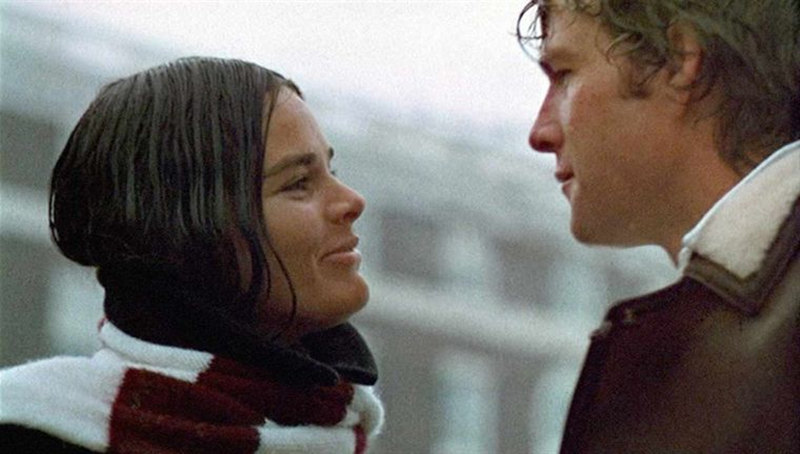If you can’t wait to hear Hugh Jackman sing the role of Jean Valjean in “Les Misérables” when it opens in theaters on December 25, you might consider picking up a copy of the 1999 London stage revival of “Oklahoma!” that’s coming to Blu-ray on December 4.
A year before he was drafted to play Logan/Wolverine in “X-Men,” Jackman sang and sashayed his way to critical acclaim as Curly in this timeless Rodgers & Hammerstein musical, and director Trevor Nunn had the foresight to film the production. It was broadcast on PBS and sold on DVD the fall of 2003. This will be the first time it’s available in high definition.
I’ll confess that I didn’t know anything about the London revival, and like so many I had only heard Jackman sing when he hosted the 2009 Oscars. So I popped this version into my Blu-ray player thinking it a curiosity. After all, how likely was it to equal the original Broadway production (1943-48), or the beloved 1955 film adaptation starring Shirley Jones and Gordon MacRae?
Funnily enough, it turns out that this London production with an international cast is BETTER than previous versions, and I’m not the only one who thinks so. Rodgers’ daughter is filmed on camera for one of the bonus features saying she also thinks it’s the best production to date. What makes it a terrific film version is that they didn’t just put three or four stationary cameras in the audience in order to capture a live performance. They filmed a performance under controlled conditions to get the right lighting, the right sound, and a cinematic style. There’s no applause, and although an audience from one of the performances is shown at the end giving a standing ovation, they weren’t in the seats for this particular show, which was treated as a closed set.
At first it felt a little strange having a high-energy number end and hearing not even the sound of one hand clapping. But then you begin to appreciate that there’s also no applause to affect the actors’ timing. Despite the show’s minimalist backdrop and props, to create a more cinematic feel the camera pulls in for tight two-shots and three-shots most of the time and deliberately eliminates the big-stage look, pulling back only to show us the stage revolves to produce a new set, or a big number that fills out the entire stage to remind us that we’re watching a staged performance. Otherwise, Paul Wheeler’s filming is so tight and the camera movements so cinematic that it really does start to feel like a film. Video coordinator Tibor Kuo really functions like a second director, and it shows in the final product.
What’s more, the music and choreography have been completely modified, and I would have to say successfully. This version of “Oklahoma!” seems more fluid and high-energy as a result. But the biggest change is the tone and basic storytelling. All of the characters seem better developed.
While I liked the music in “Oklahoma!” and loved Shirley Jones in the film version, I have to admit that the musical always struck me as an odd bird: or rather, a cheery birdbath interrupted briefly at the climax by a vulture that flew in and set fire to the place because he wasn’t one of the lovebirds. It was a story about Curly, a cowboy, who sang songs and tried to court the virginal Laurey, while loose-girl Ado Annie found herself going for whatever guy she was with—and in the play, that was a traveling salesman named Ali Hakim and a cowboy named Will Parker. Laurey’s Aunt Eller was the sage and comic relief, and Jud was Aunt Eller and Laurey’s hired hand who seemed brooding and obviously had a thing for Laurey. But the character of Ali Hakim always seemed out of place, and the brooding Jud and the song Curly sings with him, “Poor Jud Is Daid,” seemed artificially inserted to create some sort of obstacle to the happy couple and their “Surrey with the Fringe On Top.”
Under Nunn (“Cats,” “Les Misérables”), the story takes a much darker turn and, surprisingly, makes more sense in the process. He explores the darker sides of both the Ali Hakim character and Jud, with the latter no longer just a brooding guy who wishes he could get the girl. In this version of “Oklahoma!” Jud is a stalker, a menace, a guy with a history like John Steinbeck’s Lenny in “Of Mice and Men” so that he seems a danger in every scene. He’s psychotic, and in the “Poor Jud Is Dead” scene there are some chilling moments between Jud and Curly. It’s even chillier when he’s alone with Laurey, and in a scene where people bid on “box lunches” and picnic baskets and get to escort the maker of the box/basket to the town social, a bidding war between Curly and Jud carries a similar sense of underlying tension.
My 10-year-old daughter loves musicals, but this one frightened her. Though there’s no rating, I’d have to say that it would probably merit a PG because of the dark menace that Jud projects. Happily, there’s enough music and comedy to balance those moments, and while on the one hand “Oklahoma!” doesn’t stray so far that it’s unrecognizable, the changes are significant and profound. With them, the story makes more sense, and you also get a sense of the uneasy coexistence that farmers and cowboys experienced in Oklahoma when it was still a territory.
“Oklahoma!” was the first musical collectively written by Richard Rodgers and Oscar Hammerstein, and it was the first musical to give so much prominence to narration and story development. It also surprised theater-goers with a 15-minute “dream” ballet that was cut back for the Oscar-winning film adaptation but reinstated and re-choreographed here with Jackman and Gabrielle doing their own dancing—unlike previous productions that used doubles.
Jackman is superb as Curly, and Shuler Hensley is positively spine-tingling as Jud. This production also offers an Ali Hakim who wasn’t just an assumed name taken by a white snake-oil peddler to sell exotic wares. In this case it’s a real “foreigner” (Peter Polycarpou) who’s played as less the fool and more the cunning seducer of women. As Ado Annie, Vicki Simon sometimes drifts between a hayseed accent/dialect and a pure stage voice, but she seems right for the part. That’s not the case with Josefina Gabrielle, who seems too sophisticated to be the rosy-cheeked, fresh-faced Laurey. Her facial features are a little harsh and angular, and she wears a little too much make-up (with plucked and penciled eyebrows) for a barefooted farm girl. Despite this one misstep in casting—for she acts and sings her heart out, like everyone else—this version of “Oklahoma!” is a stunner.
Jackman as Curly gets to sing the opening “Oh What a Beautiful Mornin’,” as well as “The Surrey with the Fringe on Top” with Laurey and Aunt Eller, a duet with Laurey (“People Will Say We’re in Love”) and Jud (“Poor Jud is Daid”), and he whoops it up in the ensemble numbers (“The Farmer and the Cowman,” “Oklahoma!”). But he’s not the glue that holds this production together. Even when he’s not involved, a song like the men singing “Kansas City” is a show-stopper, while “Many a New Day” sung by the women is toe-tappingly memorable. So is Ado Annie’s “I Cain’t Say No” and Jud’s ballad of the “Lonely Room.” The cast really brings this production to life, and Nunn’s decisions to go darker and to film it cinematic style pay big dividends.
Video:
There was only one hitch in playback at the start of the dream ballet sequence. And several of the two-shots posed a problem for the cameras to focus. But the AVC/MPEG-4 transfer shows no ghosting, no excessive DNR, no banding issues, and only slight crush in several scenes. It’s a solid video presentation, with the 1.78:1 widescreen aspect ratio just the ticket for a stage production like this. Colors are true-looking, and normally difficult-to-film stage lighting has been supplemented by key lighting that makes the scenes look great. The “Poor Jud Is Daid” song and that entire sequence in Curly’s bunkhouse is filmed in very low light for dramatic effect, but no detail is lost and there’s no grain or noise to mar the image.
Audio:
The audio is an English DTS-HD MA 2.0 that feels more robust than the average 2.0, but it’s still not nearly as dynamic as the 5.1 or 7.1 tracks you’re used to. But remember, there are no boom mics, and the sound is dependent upon the mics that the cast members are wearing. As with the video there are a few hitches, but they’re brief and nothing to detract from the experience.
Extras:
There’s not much here—a brief “Making of ‘Oklahoma!” the only feature to speak of, and it feels like a promo.
Bottom line:
This version of “Oklahoma!” won Outstanding Musical Production, Best Set Designer, Best Choreographer, and Best Supporting Performance (Hensley) at the 1999 Laurence Olivier Awards—Britain’s version of the Tony Awards. Though he wasn’t recognized, Jackman beats MacRae and all other Curlys hands down. He headlines a talented cast in a production that finally makes all of the elements of the Rodgers & Hammerstein musical come together logically.


